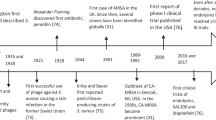Abstract
This study was designed to evaluate the effect of phage-antibiotic synergy in reducing antibiotic resistance. The initial numbers of Staphylococcus aureus treated with ciprofloxacin, phages, and combination were significantly reduced by 3.47, 4.62, and 5.75 log CFU/mL, respectively, at the early 12 h of incubation. The combination treatment most effectively inhibited the growth of S. aureus, showing more than 4 log reduction in 18 h of incubation at 37°C. The significant reduction in biofilm formation by S. aureus was observed at the combination treatment (3.91 log). Ciprofloxacin-treated S. aureus cells became resistant to both ciprofloxacin and phage, showing the mutant frequencies of 27% and 25%, respectively, whereas no antibiotic- and phage-resistant S. aureus cells were observed at the combined treatment of ciprofloxacin and phages. These results provide useful information for reducing the risk of antibiotic resistance in human and food animals.
Similar content being viewed by others
References
Sergelidis D, Papadopoulos T, Komodromos D, Sergelidou E, Lazou T, Papagianni M, Zdragas A, Papa A. Isolation of methicillin-resistant Staphylococcus aureus from small ruminants and their meat at slaughter and retail level in Greece. Lett. Appl. Microbiol. 61: 498–503 (2015)
Hanberger H, Walther S, Leone M, Barie PS, Rello J, Lipman J, Marshall JC, Anzueto A, Sakr Y, Pickkers P, Felleiter P, Engoren M, Vincent J-L. Increased mortality associated with meticillin-resistant Staphylococcus aureus (MRSA) inf ection in t he I ntensive C are Unit: R esults from the EPIC I I study. Int. J. Antimicrob. Ag. 38: 331–335 (2011)
Haaber J, Cohn MT, Frees D, Andersen TJ, Ingmer H. Planktonic aggregates of Staphylococcus aureus protect against common antibiotics. PLoS ONE 7: e41075 (2012)
Penesyan A, Gillings M, Paulsen I. Antibiotic discovery: Combatting bacterial resistance in cells and in biofilm communities. Molecules 20: 5286–5298 (2015)
Hede K. Antibiotic resistance: An infectious arms race. Nature 509: S2–S3 (2014)
Kirby AE. Synergistic action of gentamicin and bacteriophage in a continuous culture population of Staphylococcus aureus. PLoS ONE 7: e51017 (2012)
Woo J, Ahn J. Assessment of synergistic combination potential of probiotic and bacteriophage against antibiotic-resistant Staphylococcus aureus exposed to simulated intestinal conditions. Arch. Microbiol. 196: 719–727 (2014)
Coulter L, McLean R, Rohde R, Aron G. Effect of bacteriophage infection in combination with tobramycin on the emergence of resistance in Escherichia coli and Pseudomonas aeruginosa biofilms. Viruses 6: 3778–3786 (2014)
Qimron U, Marintcheva B, Tabor S, Richardson CC. Genomewide screens for Escherichia coli genes affecting growth of T7 bacteriophage. P. Natl. Acad. Sci. USA 103: 19039–19044 (2006)
Labrie SJ, Samson JE, Moineau S. Bacteriophage resistance mechanisms. Nat. Rev. Microbiol. 8: 317–327 (2010)
Partridge SR. Analysis of antibiotic resistance regions in Gram-negative bacteria. FEMS Microbiol. Rev. 35: 820–855 (2011)
CLSI. Methods for dilution antimicrobial susceptibility tests for bacteria that grow aerobically. Approved standard M07-A8 (2009)
Freeman DJ, Falkiner FR, Keane CT. New method for detecting slime production by coagulase negative staphylococci. J. Clin. Pathol. 42: 872–874 (1989)
Comeau AM, Tétart F, Trojet SN, Prère M-F, Krisch HM. Phage-antibiotic synergy (PAS): ß-Lactam and quinolone antibiotics stimulate virulent phage growth. PLoS ONE 2: e799 (2007)
Tanji Y, Shimada T, Yoichi M, Miyanaga K, Hori K, Unno H. Toward rational control of Escherichia coli O157:H7 by a phage cocktail. Appl. Microbiol. Biot. 64: 270–274 (2004)
Høiby N, Bjarnsholt T, Givskov M, Molin S, Ciofu O. Antibiotic resistance of bacterial biofilms. Int. J. Antimicrob. Ag. 35: 322–332 (2010)
Ahn J, Kim S, Jung L-S, Biswas D. In vitro assessment of the susceptibility of planktonic and attached cells of foodborne pathogens to bacteriophage P22-mediated Salmonella lysates. J. Food Protect. 76: 2057–2062 (2013)
Ryan EM, Alkawareek MY, Donnelly RF, Gilmore BF. Synergistic phageantibiotic combinations for the control of Escherichia coli biofilms in vitro. FEMS Immunol. Med. Mic. 65: 395–398 (2012)
Pourmand MR, Abdossamadi Z, Salari MH, Hosseini M. Slime layer formation and the prevalence of mecA and aap genes in Staphylococcus epidermidis isolates. J. Infect. Dev. Ctries. 5: 34–40 (2011)
Stewart PS, William CJ. Antibiotic resistance of bacteria in biofilms. The Lancet 358: 135–138 (2001)
Fung-Tomc J, Kolek B, Bonner DP. Ciprofloxacin-induced, low-level resistance to structurally unrelated antibiotics in Pseudomonas aeruginosa and methicillin-resistant Staphylococcus aureus. Antimicrob. Agents Ch. 37: 1289–1296 (1993)
Campion JJ, McNamara PJ, Evans ME. Evolution of ciprofloxacin-resistant Staphylococcus aureus in in vitro pharmacokinetic environments. Antimicrob. Agents. Ch. 48: 4733–4744 (2004)
Mizoguchi K, Morita M, Fischer CR, Yoichi M, Tanji Y, Unno H. Coevolution of bacteriophage PP01 and Escherichia coli O157:H7 in continuous culture. Appl. Environ. Microb. 69: 170–176 (2003)
Author information
Authors and Affiliations
Corresponding author
Rights and permissions
About this article
Cite this article
Jo, A., Kim, J., Ding, T. et al. Role of phage-antibiotic combination in reducing antibiotic resistance in Staphylococcus aureus . Food Sci Biotechnol 25, 1211–1215 (2016). https://doi.org/10.1007/s10068-016-0192-6
Received:
Revised:
Accepted:
Published:
Issue Date:
DOI: https://doi.org/10.1007/s10068-016-0192-6




